Page 7 of 452
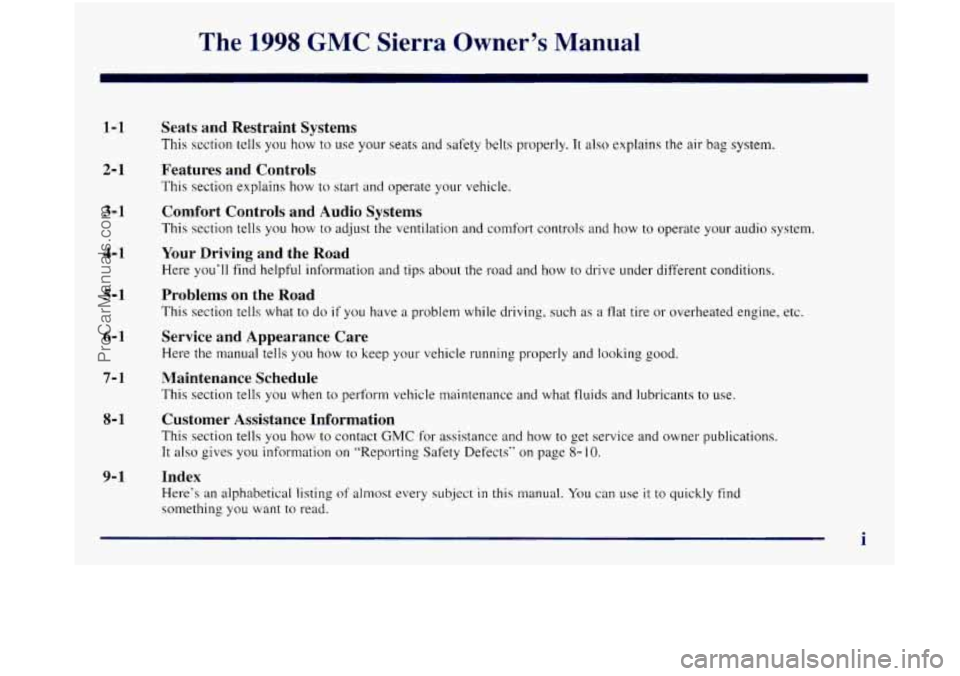
The 1998 GMC Sierra Owner's Manual
1-1
2- 1
3- 1
4- 1
5-1
6-1
7-1
8- 1
9-1
Seats and Restraint Systems
This section tells you how to use your seats and safety belts properly. Tt also explains the air bag system.
Features and Controls
This section explains how to start and operate your vehicle.
Comfort Controls and Audio Systems
This section tells you how to adjust the ventilation and comfort controls and how to operate your audio system.
Your Driving and the Road
Here you'll find helpful information and tips about the road and how to drive under different conditions.
Problems on the Road
This section tells what to do if you have a problem while driving? such as a flat tire or overheated engine, etc.
Service and Appearance Care
Here the manual tells you how to keep your vehicle running properly and looking good.
Maintenance Schedule
This section tells you when to perform vehicle maintenance and what fluids and lubricants to use.
Customer Assistance Information
This section tells you how to contact GMC for assistance and how to get service and owner publications.
It also gives you information on "Reporting Safety Defects" on page 8- 10.
Index
Here's an alphabetical listing of almost every subject in this manual. You can use it to quickly find
something you want to read.
i
ProCarManuals.com
Page 13 of 452
Section 1 Seats and Restraint Systems
Here you’ll find information about the seats in your vehicle and how to use your safety belts properly. You can also
learn about some things you should not do with air bags and safety belts.
1-2 1-9
1-13
1- 14
1- 14
1-22
1-23
1-23
1-32 Seats
and Seat Controls
Safety Belts: They’re for Everyone
Here Are Questions Many People
Ask About
Safety Belts
-- and the Answers
How to Wear Safety Belts Properly
Driver Position
Safety Belt Use During Pregnancy
Right Front Passenger Position
Air Bag System
Center Passenger Position 1-34
1-40
1-42
1-45
1-67
1-70
1-70
1-70 Rear
Seat Passengers
Rear Safety Belt Comfort Gu’ides for
Children and Small Adults
Children
Child Restraints
Larger Children Safety Belt Extender
Checking Your Restraint Systems
Replacing Restraint System Parts After
a Crash
ProCarManuals.com
Page 14 of 452
Seats and Seat Controls
This section tells you about the seats -- how to adjust
them, and fold them up and down. It also tells you about
reclining front seatbacks and head restraints.
Manual Front Seat
I /! CAUTIO-.:
You can lose control of the vehicle if you try to
adjust a manual driver’s seat while the vehicle
is
moving. The sudden movement could startle and
confuse you, or make you push a pedal when you
don’t want to. Adjust the driver’s seat only when
the vehicle is
not moving.
If your vehicle has a manual
bucket, split bench or full
bench seat, you can adjust it
with
this lever at the front
of the seat.
Slide the lever at the front of
the seat toward the
passenger’s side to
unlock it. Using your body, slide the
seat to where
you want it. Then, release the lever and try
to move the seat with your body in order to make sure
the seat
is locked into place.
1-2
ProCarManuals.com
Page 17 of 452
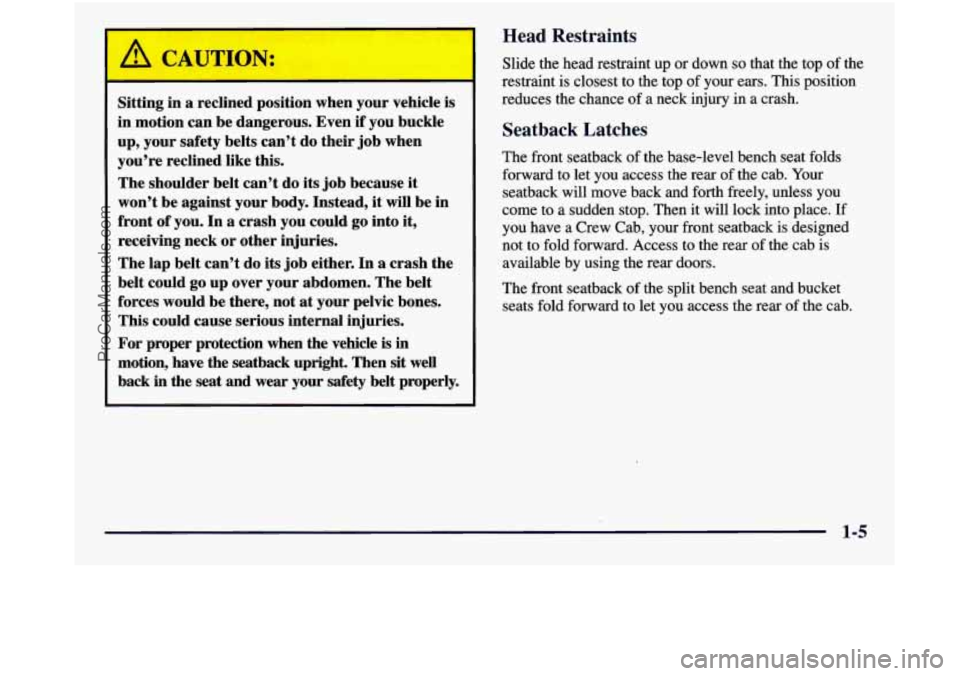
Sitting in a reclined position when your vehicle is
in motion can be dangerous. Even if you buckle
up, your safety belts can’t do their job when
you’re reclined like this.
The shoulder belt can’t
do its job because it
won’t be against your body. Instead,
it will be in
front of you. In a crash you could go into it,
receiving neck or other injuries.
The lap belt can’t do its job either. In a crash the
belt could go up over your abdomen. The belt
forces would be there, not
at your pelvic bones.
This could cause serious internal injuries.
For proper protection when the vehicle
is in
motion, have the seatback upright. Then sit well
back in the seat and wear your safety belt properly.
~~
Head Restraints
Slide the head restraint up or down so that the top of the
restraint is closest to the top of your ears. This position
reduces the chance of a neck injury in a crash.
Seatback Latches
The front seatback of the base-level bench seat folds
forward
to let you access the rear of the cab. Your
seatback will move back and forth freely, unless you
come to a sudden stop. Then it will lock into place.
If
you have a Crew Cab, your front seatback is designed
not to fold forward. Access to the rear of the cab is
available by using the rear doors.
The front seatback
of the split bench seat and bucket
seats fold forward to let you access the rear of the cab.
1-5
ProCarManuals.com
Page 18 of 452
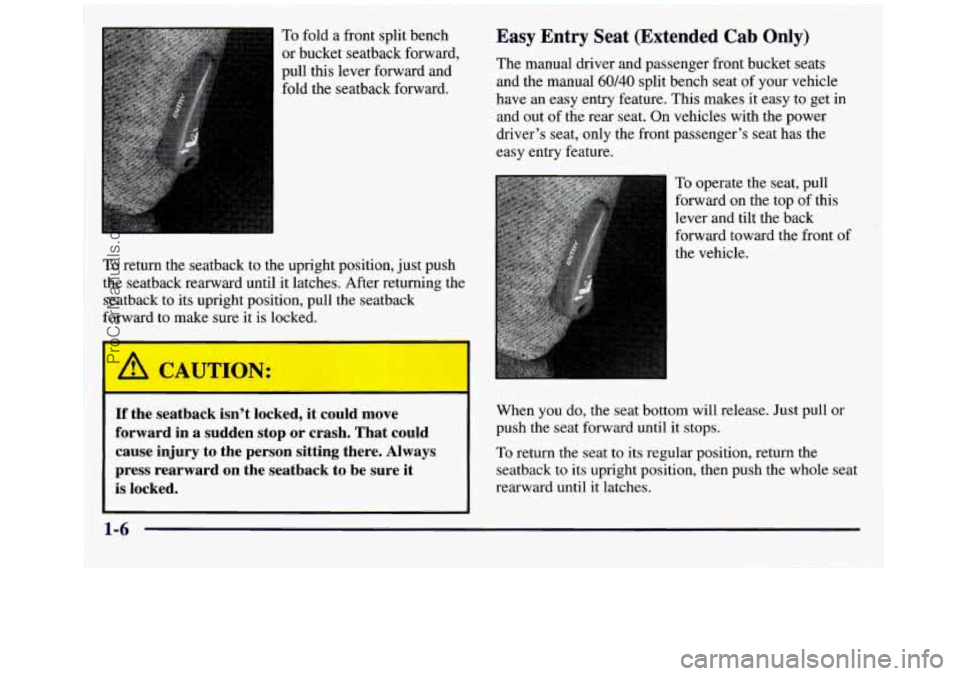
~ ~ ~~ ~~
~~ ~ ~~ To fold a front split bench
or bucket seatback forward,
pull this lever forward and
fold the seatback forward.
To return the seatback to the upright position, just push
the seatback rearward until it latches. After returning the
seatback to its upright position, pull the seatback
forward to make sure it is locked.
If the seatback isn’t locked, it could move
forward in
a sudden stop or crash. That could
cause injury to the person sitting there. Always
press rearward on the seatback to be sure
it
is locked.
Easy Entry Seat (Extended Cab Only)
The manual driver and passenger front bucket seats
and the manual
60/40 split bench seat of your vehicle
have an easy entry feature. This makes it easy to get in
and out of the rear seat. On vehicles with the power
driver’s seat, only the front passenger’s seat has the
easy entry feature.
To operate the seat, pull
forward on the top of this
lever and tilt the back
forward toward the front of
the vehicle.
When you do, the seat bottom will release. Just pull or
push the seat forward until it stops.
To return the seat to its regular position, return the
seatback to its upright position, then push the whole seat
rearward until it latches.
1-6
ProCarManuals.com
Page 21 of 452
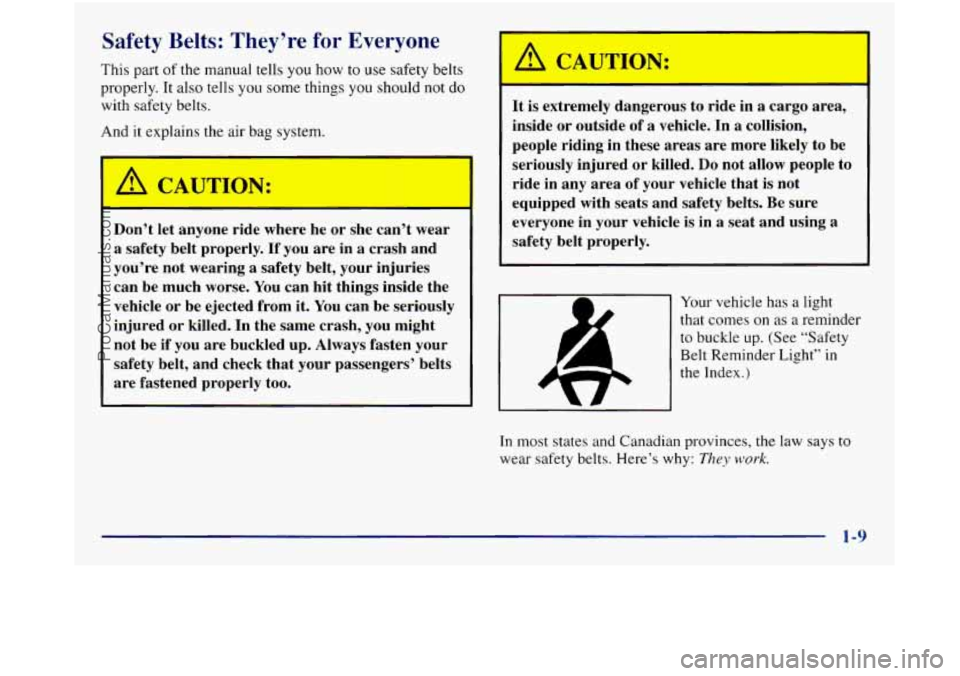
Safety Belts: They’re for Everyone
This part of the manual tells you how to use safety belts
properly. It also tells you some things
you should not do
with safety belts.
And it explains the air bag system.
’
A CAUTION:
I
- -
Don’t let anyone ride where he or she can’t wear
a safety belt properly. If you are in
a crash and
you’re not wearing
a safety belt, your injuries
can be much worse.
You can hit things inside the
vehicle or be ejected from it.
You can be seriously
injured or killed. In the same crash, you might
not be if you are buckled up. Always fasten your
safety belt, and check that your passengers’ belts
are fastened properly too. It
is extremely dangerous to ride in a cargo area,
inside or outside of a vehicle.
In a collision,
people riding in these areas are more likely to be
seriously injured or killed. Do not allow people to
ride in any area of your vehicle that is not
equipped with seats and safety belts. Be sure
everyone in your vehicle is in a seat and using a
safety belt properly.
Your vehicle has a light
that comes
on as a reminder
to buckle
up. (See “Safety
Belt Reminder Light” in
the Index,)
In most states and Canadian provinces, the law says
to
wear safety belts. Here’s why: They work.
1-9
ProCarManuals.com
Page 26 of 452
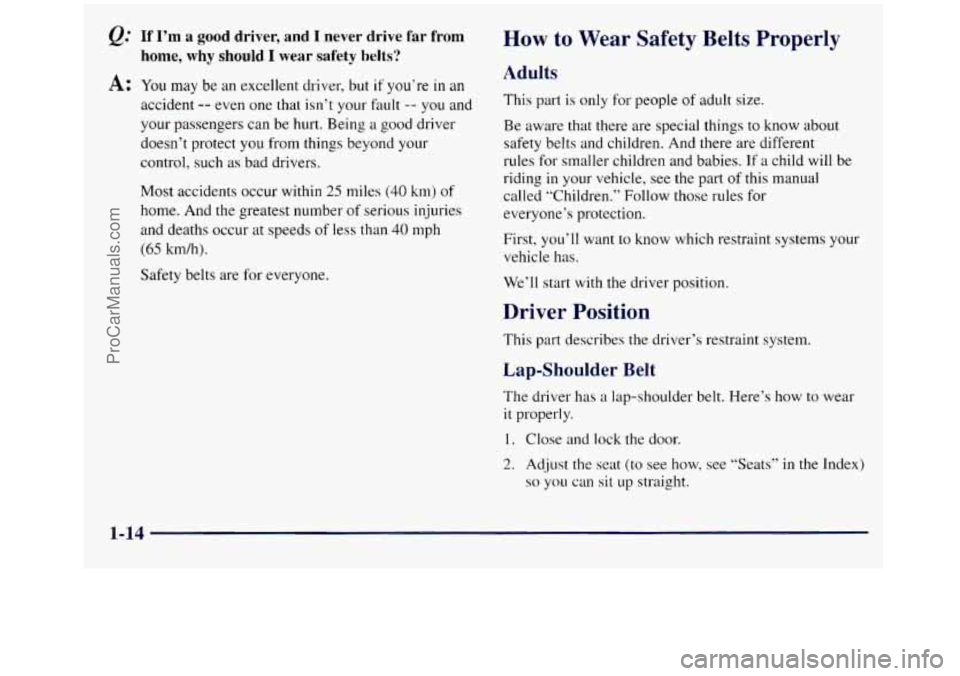
Q: If I’m a good driver, and I never drive far from
home, why should I wear safety belts?
A: You may be an excellent driver, but if you’re in an
accident -- even one that isn’t your fault -- you and
your passengers can be hurt. Being
a good driver
doesn’t protect you from things beyond your
control9 such
as bad drivers.
Most accidents occur within
25 miles (40 km) of
home. And the greatest number of serious injuries
and deaths occur at speeds
of less than 40 mph
(65 km/h).
Safety belts are for everyone.
How to Wear Safety Belts Properly
Adults
This part is only for people of adult size.
Be aware that there are special things to know about
safety belts and children. And there are different
rules for smaller children and babies.
If a child will be
riding
in your vehicle, see the part of this manual
called “Children.” Follow those rules for
everyone’s protection.
First, you’ll want to know which restraint systems your
vehicle has.
We’ll start
with the driver position.
Driver Position
This part describes the driver’s restraint system.
Lap-Shoulder Belt
The driver has a lap-shoulder belt. Here‘s how to wear
it properly.
1. Close and lock the door.
2. Adjust the seat (to see how, see “Seats” in the Index)
so you can sit up straight.
1-14
ProCarManuals.com
Page 44 of 452
Center Passenger Position
Lap Belt
If your vehicle has front and rear bench seats, someone
can sit in the center positions. Rear (Extended and Crew Cab)
1-32
ProCarManuals.com